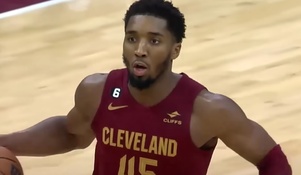Fixing the NBA Draft
If you've read either of my pieces on the NBA draft (click this link to my draft reaction piece 400,000,000 times, please), then you probably know that I love the NBA draft (because I tell you that I love the NBA draft), but that doesn't mean that the draft is perfect. The two points I'm going to address in this piece are what changes I'd make to the draft process (reducing tanking being the main goal) and what changes I'd like to see made to who is draft eligible (the one-and-done rule). A couple years ago, Zach Lowe wrote a piece for Grantland where he details the different proposals being made for changes to the draft lottery, if you haven't read that piece then here's the link, so that you can look at the various reformation ideas out there (probably all better than my idea, but at least mine is...newer?). Also, if you haven't read Zach Lowe's work then why are you even here right now? If you have somehow stumbled across my lowly NBA blog without having ever read anything by Zach Lowe, then click that link above and get lost in his NBA rabbit hole (not a euphemism). You can then come back here, and subscribe to my blog (which seems much worse now after reading Zach Lowe's stuff) as a thank you...to me...you're welcome, unnamed (but incredibly special in your own way) reader!

It seems that the majority of proposed changes to the draft lottery have to do with the odds each lottery team has at landing the number one pick. Some people want all the lottery teams to have the same chance of moving up to number one, some want the six worst teams to have the same odds, some want the innovative "wheel" idea, which is the main topic in the Lowe column above. My idea is far simpler, however. Notice how I'm building suspense that will almost certainly lead to a major letdown when you hear my actual idea? This paragraph is basically the equivalent to every M. Night Shyamalan movie not titled "The Sixth Sense". Anyway, I think that the top pick should be up for sale every year. The league could do a silent auction type of thing where each team would submit their bid to the league office, and the team with the highest bid gets the pick. The catch being that teams can only bid what they could fit under the salary cap, because the winning team has to pay whoever they take with the top pick the amount that they bid. Since bad teams typically have more cap space, this gives bad teams somewhat of an upper-hand, which allows them to sell hope to their fan bases (except for the Kings. There is no hope in Sacramento. There is only Vlade). Every lottery team has hope with the current system (again, except for The Team That Shall Not Be Named), since each team in the lottery has a chance to move up. Unlike the current system, the top pick auction affords middle of the pack and playoff teams the chance to move to the top of the draft as well, and potentially move into contender status.

One of the hardest things for NBA teams to do is to move from being a good team to a great team. The top pick auction affords these good teams the chance to make the jump through the draft. A team like the Atlanta Hawks, who have been good for the last two years but have been unable to get over the hump, could've decided to make a serious attempt at grabbing the number one pick this year, especially since Horford is a free agent, opening up extra cap space for the Hawks. Atlanta could've made a bid of, say, 10 million dollars, and if they had won the pick they would draft Ben Simmons and sign him for 10 million a year for four years (2 year + 2 year-team option, just like normal). They could then go over the cap to re-sign Horford (since they have his Bird rights), which would greatly improve their team.
This also can help speed up the rebuilding process for bottom of the barrel teams (expecting a Kings joke here? Well how dare you, sir/madam/Caitlyn Jenner, I would never stoop to such depths). Since the rest of the lottery would play out as normal, except with picks 2-4 instead of 1-3, a team in the top 3 could get two elite talents instead of one and make a huge jump should they win the top pick auction. Take the Sixers, for example. Philly won the draft lottery and the number one pick this year. They also have tons and tons of cap space and could choose to use that space to go for the top pick, which would give them picks 1 and 2 under my system. This would add both Ben Simmons and Brandon Ingram to the Sixers, which, even if that doesn't make them a playoff team for this coming season, it puts their stars on the same timeline so that they improve/peak together.

The contract for the top pick would be set up like the other top picks (2 years + 2-year team option), the only difference being the player's salary. The big question would be timing for this auction. I think it would need to come after the lottery for picks 2-14, so that teams can decide if this is the year they want to go all in for the top pick. To be clear, teams don't lose their normal pick in the draft, the top pick would just be an extra pick for that one team. I think it also needs to come after the deadline for players/teams to exercise or decline their option year(s), which would require changing the off-season schedule. My suggestion is that we hold the draft lottery at the regular time (start of conference finals), announce the top pick auction winner one week later, move the deadline for options up to the usual draft time (late June) and then hold the draft in early July, with free agency starting roughly a week after the draft.
The top pick auction system (we really need a better name for that. I'd ask readers to send in suggestions, but that would only give me one other name...) is certainly not perfect, but it gives every team an avenue to improve, which can be especially valuable to teams that aren't often top destinations for big name free agents (Atlanta, Detroit, Milwaukee, Utah, etc.). These teams can get potential stars for at least four years by winning the TPA (the abbreviation sounds like something found in processed foods that will soon be linked to cancer). Feel free to leave questions down below or comment with your own idea on draft reform. Maybe one of our ideas will gain traction and eventually lead to a 30 for 30 ("What if I told you (dramatic pause) that a blog with literally dozens of views changed the NBA...and gave even the Kings a chance to be great). I'll be waiting by the phone, Mr. Silver.
On to draft eligibility. I promise this will be shorter than the draft reform section (but not any more interesting). As the rules stand right now, basketball players may declare for the draft after being one year removed from high school, which usually manifests itself in playing a year of college ball before going pro. Some guys have decided to play professionally overseas for their one year after high school (Brandon Jennings, Emmanuel Mudiay, etc.), and one guy decided to just pretend like he was a year removed from high school and see if anybody noticed (Thon Maker). Luckily for Thon, his handler is a Jedi and told Adam Silver that this was not the high schooler he was looking for; Maker went on to get drafted tenth overall.
Most people seem to dislike the one-and-done rule, they either think that kids should be allowed to go straight from high school to the NBA, or that they should have to stay in school for at least two years. Well, here's the part where I make everybody like me, my idea incorporates both. I suggest that players can become draft eligible after their senior year of high school, but that they don't have to play in the NBA right away. If a player gets taken in the second round or just decides that they can improve their stock by playing in college, then they can choose to play for two years before they can re-enter the draft. This same rule would apply for any college player who gets selected, as well. A team would own the player's draft rights for two years, and then the player would re-enter the draft pool if an agreement was not worked out. Looking at it from an NBA team's point of view, this would allow the team to draft and stash players in college if they felt they weren't ready for a year or two, instead of having to draft international players to stash overseas (there were roughly 97 international players taken this year).

This gives the rare NBA-ready high school player the opportunity to jump straight to an NBA team, while also allowing players with potential to develop in college, see how they fare in the draft, and then choose to join the team or try to improve their stock. NBA teams, meanwhile, have the option of selecting young American players and watching their development as they play in college. Win-win-win (I won, too, didn't you see the trophy). Feel free to leave comments about ways to improve my ideas or change them altogether. Just don't call anyone any mean names. Except the Kings.




